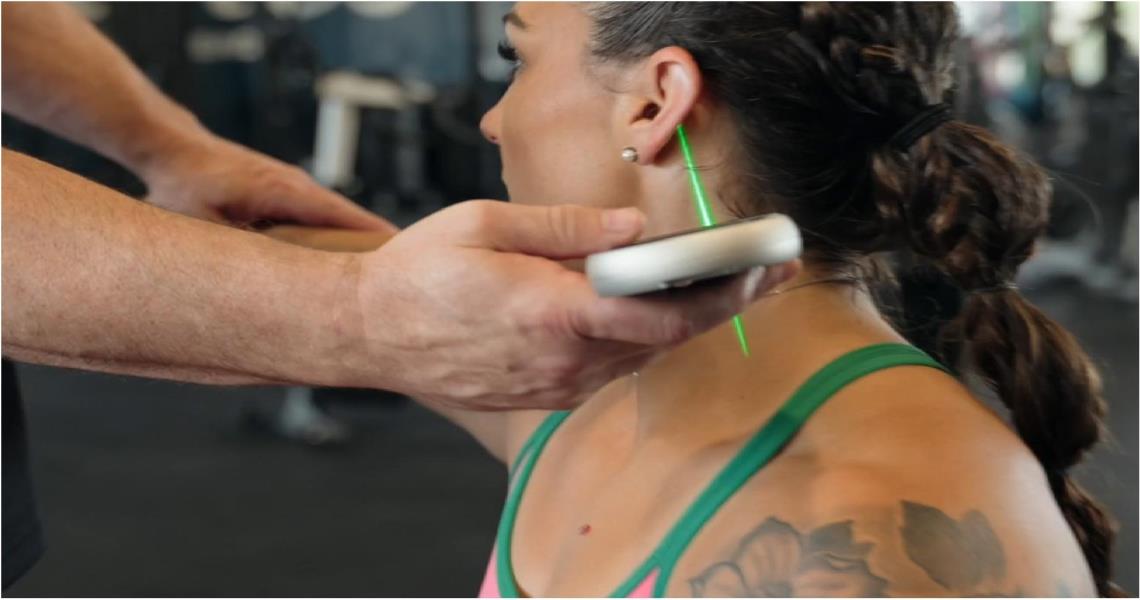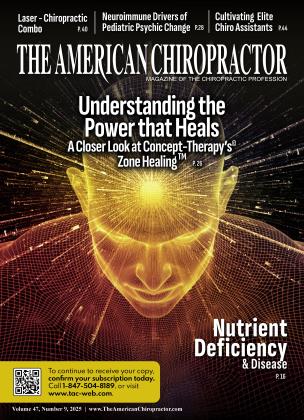
IF YOU TURN ON YOUR TV, YOU’LL BE BOMBARDED WITH “BIG PHARMA” ADS for chronic pain. When I was in the UK lecturing on lasers, European doctors mentioned how strange it was to see those kinds of ads because direct-to-consumer drug marketing is illegal in most of Europe.
However, in the U.S., Americans are constantly fed these ads, and then we see the fallout from the opioid epidemic they helped fuel as lives are devastated by addiction. That’s why it’s critical to offer real alternatives to pharmaceutical “solutions.”
Fortunately, research shows chiropractic care combined with high-energy lasers is not only a safer option but also a far more effective one. This has been known for decades. In 1974, Russian researchers found that 635 mn pulsed red lasers were so effective for a variety of conditiowns that they were integrated into the country’s state-sponsored medical system.
I coauthored a literature review published in the Journal of Orthopedics and Rheumatology that compared the effectiveness of 635 nm red lasers to red light LEDs, NSAIDs, and opioids for chronic low back pain, plantar fasciitis, and other conditions.
Our findings were clear: lasers outperformed drugs and red light therapy in reducing pain and in actually triggering tissue repair and producing long-term benefits. On average, lasers delivered six to seven times better results than red light therapy for reducing pain and increasing range of motion. They also had longer-lasting effects.
Based on these findings, lasers should be considered before fuming to dragbased approaches, especially for patients at risk of addiction. Add chiropractic adjustments into the mix, and your results become even more powerfill.
This is where many people get tripped up by laser marketing myths. Some sales reps still claim red lasers are only good for superficial issues even though high-quality doubleand quadruple-blind studies show they have significant effects on deeper tissues. Most reps simply don’t understand the difference between high-energy and low-energy wavelengths.
High-energy wavelengths (those below 730 mn) include violet, green, and red. These carry electron volt (eV) energy levels above the 1.7 eV threshold required to trigger photochemical and photo signaling reactions. Violet comes in at 3.1 eV, green at 2.4 eV, and red at 1.9 eV. By contrast, longer wavelengths like infiaied fall below the 1.7 eV threshold and instead rely on molecular vibration and direct tissue penetration.
A helpful analogy: ultraviolet (UV) light penetrates only a few microns into the skin, but it triggers vitamin D production, which impacts bone health, inflaimnation, and immunity. Babies with jaundice are treated with blue light that doesn’t directly penetrate the liver but still affects liver function.
Top Russian laser researcher Sergey Moskvin has shown that high-eV red lasers can affect deep tissue indirectly by targeting blood vessels and successfully treating conditions such as chronic bronchial asthma.
Many clinicians assume violet, green, and red lasers can’t reach spinal discs due to depth. However, independent studies show these wavelengths stimulate extracellular matrix-modifying enzymes that promote annular repair and help in degenerative disc disease by reducing pain and facilitating repair.
At the University of Illinois Medical Center in Chicago, the same wavelengths were studied for their effects on chronic renal fibrosis. While you can’t market lasers as kidney treatments, it’s exciting to know that treating chronic low back pain may also yield kidney-supportive effects.
In our double-blind, placebo-controlled studies, eight hands-free, unattended 20-minute sessions (twice per week) with a 635 nm red laser reduced chronic low back pain by 58%. Even more compelling, subjects reported an additional 17.48% pain reduction 12 months later, bringing average improvement to over 75% using only a 3-diode scanning laser. Add adjustments, and outcomes improve even further.
For plantar fasciitis, just six 1 O-minute sessions twice a week produced similar success. These studies led to FDA clearances for both conditions. More recently, class II non-thermal lasers also received full-body clearance for post-operative pain and inflammation, accelerating surgical recovery by 30-70%.
Dr. Robert Silverman and I also published research on green and violet lasers for chr onic neck and shoulder pain, which led to the first FDA clearance for those wavelengths for chronic pain. Our study used the most energetic combination available and compared it to red/violet, dual red, and red light therapy.
In a single, 13-minute hands-free session (six minutes each side, one minute top of head), 81% of participants (each with a five-year minimum history of pain) reported at least a 30% pain reduction. Even more impressive, their pain levels continued to decrease over the next 48 hours. Average pain reduction at the 48-hour mark was 65%, with an average 32-degree increase in range of motion. Red light showed no long-term improvement; participants’ pain returned to baseline.
The takeaway? Combining lasers with chiropractic gives you a massive edge. It builds a word-of-mouth practice. I haven’t had to advertise in over a decade because my patients do it for me.
Even better, these treatments don’t drain your time or your staff’s. While I also teach advanced neuro-rehab protocols for those who want to go deeper, the pain protocols mentioned here can all be done with unattended, efficient sessions that free you up and still deliver remarkable results.

Dr. Kirk Gair has been in private practice since 1999 and using Erchonia cold lasers since 2004. He has treated elite athletes, including Super Bowl and MLB champions, as well as national record holders. His expertise in cold laser therapy and training in functional medicine and neurology attract patients from across the U.S. Dr. Gair has been featured in the documentary The Thyroid Secret and the bestselling book Hashimoto’s Protocol by Dr. Izabella Wentz, as well as on major health platforms and podcasts. To contact Dr. Gair, call (626) 922-1414, email [email protected], or visit LaserChiropractic.net.
1. Bronfort G, Evans R. Anderson AV, Svendsen KH, Bracha Y, Grimm RH. Spinal manipulation, medication, or home exercise with advice for acute and subacute neck pain: a randomized trial. Ann Intern Med. 2012 Jan 3;156(1 Pt 1):110. doi: 10.7326/0003-4819-156-1-20120103000002. PMID: 22213489.
2. Moskvin SV. Low-level laser therapy in Russia: history, science and practice. J Lasers Med Set. 2017 Spring;8(2):56-65. doi: 10.15171/ jlms.2017.11. Epub 2017 Mar 28. PMID: 28652897; PMCID: PMC5474383.
3. Januskewski J, Bromley C, Lara CA, Gair K, Brock B. Polishuk L, Sammons, T. Efficacy of 635nm red low-level laser on nociceptive musculoskeletal pain compared to NSAIDS, opioids, and other light sources. Ortho & Rheum Open Access J. 2020;17(2):555960. doi: 10.19080/OROAJ.2020.17.555960
4. Moriyama Y, Moriyama EH, Blackmore K, Akens MK, Lilge L. hr vivo study of the inflammatory modulating effects of low-level laser therapy on iNOS expression using bioluminescence imaging. Photochem Photobiol. 2005 NovDec;81(6):1351-5. doi: 10.1562/2005-02-28-RA450. PMID: 16076245.
5. Moskvin SV, Khadartsev AA. Methods of effective low-level laser therapy in the treatment of patients with bronchial asthma (literature review). Biomedicine (Taipei). 2020 Mar 28;10(l):l-20. doi: 10.37796/2211-8039.1000. PMID: 33854908; PMCID: PMC7608842.
6. Hwang MH. Kim KS, Yoo CM, Shin JH, Nam HG, Jeong JS, Kim JH, Lee KH, Choi H. Photobiomodulation on human annulus fibrosus cells during the intervertebral disk degeneration: extracellular matrix-modifying enzymes. Lasers Med Set. 2016 May;31(4):767-77. doi: 10.1007/ S10103-016-1923-X. Epub 2016 Mar 17. PMID: 26987527.
7. O'Connor M, Patil R, Yu J, Hickey R, Premanand K, Kajdacsy-Balla A, Benedetti E, Bartholomew A. Mesenchymal stem cells synergize with 635, 532, and 405nm laser wavelengths in renal fibrosis: a pilot study. Photomed Laser Surg. 2016 Nov;34(ll):556-563. doi: 10.1089/ pho.2015.4025. Epub 2016 May 31. PMID: 27244220.
8. Berry T, Sammons T, Shanks S. Two randomized, double blind, placebo-controlled trials evaluating the efficacy of red 635nm low level laser for the treatment of low back pain. Ortho & Rheum Open Access J. 2021;17(3):555964. doi: 10.19080/OROAJ.2021.17.555964
9. Berry TS, Quarneri PJ. Roche G, Sammons TM. Low-level Laser therapy for treating low back pain: 12-month follow-up. J Pain Relief. 2020;9:347.
10. Pinto, V. Review of section 510(k) premarket notification of intent for K211186 [letter]. U.S. Food & Drug Administration. 2021 October 22. Available from: thttps://www.accessdata.fda. gov/cdrh_docs/pdf21/K211186.pdf
11. Sammons T, Gair K, Silverman RG, Shanks S. Assessing the impact of high photon energy wavelengths on the treatment of chronic neck and shoulder pain. Evid Based Complement Alternat Med. 2023 Oct 4;2023:6672019. doi: 10.1155/2023/6672019. PMID: 37829623; PMCID: PMC 10567292.
 View Full Issue
View Full Issue









